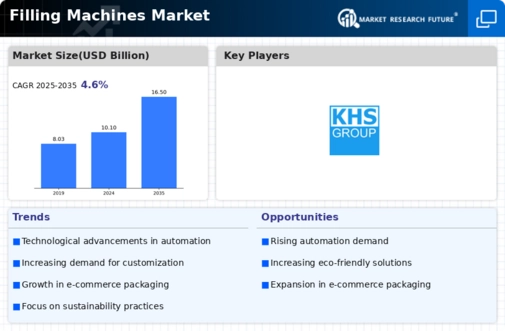Market Share
Filling Machines Market Share Analysis
In the ever-changing landscape of the Filling Machines Market, companies use different strategies for market share positioning with a view of outperforming their rivals and widening their scope. One way to do this is by distinguishing filling machines from competitors in terms of features, technology, and quality. Additionally, cost leadership is another strategy where businesses create filling machines that are cheaper than those manufactured by their rivals. By taking advantage of economies of scale, optimizing production processes, and raw material procurement, such firms can sell their goods at competitive prices. This approach works best when entering price-sensitive markets where clients mostly consider the budget rather than additional features. For one to achieve the status of being a cost leader, then he must ensure that he continuously improves the efficiency of his operation so as to maintain an edge over his competition in pricing. An important approach to market segmentation is the one employed by companies in the Filling Machines Market. Companies can penetrate niche markets and build a dedicated customer base by identifying specific customer needs and tailoring products to meet those requirements. This strategy involves understanding the diverse requirements of different industries and adapting filling machines to suit different applications such as food and beverage, pharmaceuticals, and cosmetics. Strategic partnerships and collaborations are also key to positioning their market share within the Filling Machines Market. Companies often form alliances with suppliers, distributors, or even competitors so they can leverage their strengths, thereby making it easier for them to offer an all-inclusive solution. Suppose they engage in strategic partnerships with supply chain key players. In that case, companies can streamline operations, reduce costs, and enhance the overall value proposition for customers while, at times, improving the quality of their products. Strategic partnerships also provide opportunities for joint research development initiatives, thus enabling access to new technologies and keeping up with trends in the market. Apart from this tactic, other strategies, such as customer-centric approaches, have been increasingly taking shape within the filling machine market. In this case, companies try to understand what clients need during the long product lifecycle so that services become responsive enough during that period; it is custom-made solutions and sustainably built-in relationships with customers that make manufacturers closer to them at all times better than any other way of keeping close ties between people who are involved in selling things such as training programs or assistance provided throughout maintenance process for instance." "In addition," he continues," many producers of filling machines adopt internationalization strategy in order enlarge their respective market shares." Globalization is still pushing businesses towards emerging nations where they establish a presence globally. Adaptation means changing a product too or service so that it matches the goals of locals alongside abiding by stipulated rules relating to it: this is how organizations go about expanding geographically, opening new doors to potential buyers to diversify income streams.





Leave a Comment